Marketing
Responsible marketing policies and auditing of compliance
Category D on Marketing captures the extent to which companies support all consumers, with special attention to children (including teenagers), to make healthy choices by adopting responsible marketing practices and by prioritizing the marketing of their healthier products. This category weighs in with 20% on the overall Index score companies can achieve. This section also presents the results of the unscored assessment of whether companies’ products are suitable to be marketed to children. For this purpose, World Health Organization (WHO) regional nutrient profiling models (NPMs) are used.
Category D consists of three criteria:
- D1 Marketing policy: general aspects of responsible marketing
- D2 Marketing policy: specific arrangements regarding responsible marketing to children including teens
- D3 Auditing and compliance with policy
To perform well in this category, a company should:
● Establish and implement a responsible marketing policy covering all consumers.
● The marketing policy should be comprehensive in its scope, i.e. considering all media channels and should embrace the principles of the International Chamber of Commerce (ICC) general marketing code , as well as the Framework for Responsible Food and Beverage Marketing Communications
● Establish and implement a marketing policy that explicitly covers responsible marketing arrangement for children, including channels, location/settings (like schools), and type of products.
● Companies should commit to not market any unhealthy products to children, including teens, below the age of 18.
● Commission or participate in industry-level independent audits to assess compliance with marketing policies, as well as disclosure of individual results for all types of media.
Ranking on Marketing
- D1
- Marketing policy
- D2
- Marketing to children
- D3
- Auditing and compliance
- *
- Did not provide information to ATNI
FrieslandCampina ranks first in marketing with a score of 7.9. Reasons for the company’s lead position are its consistently high scores in each criterion and its commitments and efforts to address nutrition challenges for priority populations. Mars and Nestlé come in second and third with scores above seven, reflecting advanced strategies in protecting consumers, including children, from irresponsible marketing. Although there has been a reshuffle, the top ten companies of the 2018 Index have remained in the lead. Most companies have shifted zero, one, or two ranks compared to 2018. Arla has improved its ranking the most, by five places, due to improvements such as joining the EU pledge on advertising to children, and initiating internal auditing for general audiences. Conagra has decreased its ranking position the most, also by seven places. Importantly, it was not the slight drop in Conagra’s score that made it lower its position in the rankings, which was merely 0.4 points, but rather increased scores of other companies.
Category Context
Like any other aspect of our food system, the COVID-19 pandemic has influenced marketing practices by food and beverage companies. As new realities have emerged during the pandemic, such as an increased reliance on e-commerce, food manufacturers have responded by launching new marketing campaigns and advertising. Some companies report having spent less on advertising during the lockdown period because it did not make financial sense to put resources into out-of-home advertising while people were at home. As a result, it is possible that lockdown has accelerated an already significant shift from traditional forms of advertising to online marketing. For more detailed accounts on ways in which access to healthy foods, and food and beverage marketing have been altered by COVID-19, see ATNI’s quarterly COVID-19 reports.
Evidence suggests that marketing of unhealthy food negatively impacts food choices, dietary patterns, and health. It is widely agreed by researchers and child advocates that children need special consideration with respect to marketing, because they are unable to fully understand the persuasive intent of advertisements. Children, already being a vulnerable target for marketing of unhealthy foods, could be impacted by this shift to digital marketing in a way that is more difficult to understand, trace, and regulate. There are burgeoning areas for online marketing, such as e-sports and gaming, on new platforms such as Twitch (time spent on this platform, which is particularly popular with young people, rose by almost a quarter globally during the lockdown period). For example, Kellogg is reported to have been increasing its advertising on e-sports and considering video game sponsorships to replace marketing around live sporting events. WHO has urged countries worldwide to monitor the exposure of children and teens to digital marketing.
Relevant changes in methodology
Several changes have been made in the Marketing category since the 2018 Global Index:
- Two separate auditing and compliance criteria for general audiences (D2 in 2018) and for children specifically (D4 in 2018) have for this index merged into a single auditing and compliance criterion, D3. Therefore, chapter D in the current iteration of the Global Index only has three criteria, compared to four 2018.
- The 2018 index had a separate section with specific indicators for undernutrition. In the current index, ATNI applies a more comprehensive approach using the concept of priority populations at risk of any form of malnutrition. The sections on marketing practices to reach priority populations (indicator 5 and 6 of criterion D1), which were previously reported in a separate undernutrition chapter, are now included in the general aspects of responsible marketing (criterion D1).
- Some new indicators are measured, such as the kind of products a company advertises to children, or a company’s commitments concerning the form and digital medium of advertisements in schools. Some indicators have been removed.
More details about the changes in the methodology can be found in the methodology section of this Index.
Global Index 2021 MethodologyKey findings
- The average score of all companies combined increased slightly from 3.4 in 2018 to 3.5 in 2021.
- Overall, companies score better in marketing policies for children, including teens, compared to general marketing policies and marketing and compliance. Most (20 out of 25) have a marketing policy specifically covering children. The criterion with the lowest overall score is general aspects of responsible marketing.
- Like 2018, FrieslandCampina ranks first in Marketing with a score of 7.9. The company scores consistently well in each criterion and is the only company to explicitly commit to developing and delivering marketing strategies to reach priority populations.
- Arla has made the largest improvements in its marketing policies and auditing, increasing its overall score by 2.9 points since 2018. The company has made major improvements in their auditing and compliance. Since the 2018 index, Arla has joined the EU pledge and initiated internal auditing for general audiences to complement EU pledge auditing. Additionally, the company improved their general aspects of responsible marketing, as they now apply their responsible marketing policy to more media and provide evidence of taking steps to understand and reach priority populations.
- A gap can be seen at the bottom of the rankings between non-engaging companies and engaging companies. Non-engaging companies rank at the bottom with scores ranging from zero to 0.4 (obtained by BRF), whereas of companies that engage, 2.1 is the lowest score (obtained by Conagra). This gap emphasizes why ATNI encourages companies to engage in our research process and prevent a forced score of zero points due to lack of information.
General Recommendations
Companies are encouraged to:
- expand the scope of media channels covered by their marketing policies, and explicitly outline the channels in their policies.
- align their marketing commitments with the ICC framework, and show leadership by making commitments that go beyond the framework.
- increase commitment to transparency in their marketing policies.
- explicitly commit to developing and delivering marketing strategies appropriate to reaching priority populations.
- not advertise any products to children, including teens, or only advertise products meeting WHO regional standards. If companies do choose to advertise products to children, they are recommended to use responsible marketing techniques aimed at children, including teens.
- lower audience thresholds used to restrict their advertising on media to below 25%, apply this restriction to all children below the age of eighteen, and apply this beyond measured media only.
- Extend marketing restrictions to fully cover the school environment (both primary and secondary), and other places where children, including teens, typically gather.
- Perform annual audits on their compliance with their marketing policy, where possible by an external auditor, and disclose information about this audit publicly and transparently.
- implement response mechanisms to ensure corrective measures after noncompliance with a marketing policy.
Noteworthy changes and best practices
-
- D
FrieslandCampina ranks first in general aspects of responsible marketing. Besides having the highest overall score, it is the only company to make explicit commitments for marketing strategies to reach priority populations, provides evidence of taking steps to understand and reach these populations with appropriate products through tailored marketing, and does this on a global scale.
FrieslandCampina is the only company to make explicit commitments to reach priority populations. In its “Broadening access to nutrition programme”, the company aims to help combat undernutrition by broadening the availability and affordability of healthy and fortified foods, especially for consumers at higher risk of undernutrition or micronutrient deficiencies, as a result of reduced access to healthy and affordable foods (e.g., lower income groups). In developing countries where FrieslandCampina has an operating company and where milk and milk products are not affordable or available, especially for lower income groups, the company focuses on commercial activities and non-commercial activities to reach these people. To market these products to specific populations, the company uses a promotion strategy of advertising, social media, and educational messages, all depending on the country and local distribution channels used by the target group and brand. One example is the promotion of its small-packaged and small-sized Peak product in Nigeria through TV and commercials and educational messages on Facebook.
-
- D
Arla is the only company to specifically refer to children as persons under the age of 18 years, as defined by the Convention on the Rights of the Child (CRC). In its policy, the company includes all children under the age of 18 and specifies which part of the policy applies to all children below 18 years and which part to children below 12 years. No other company extends the age range of its policy so high as under the age of 18.
-

- D
Unilever performs best amongst companies in marketing techniques and materials aimed at children and teens. The company commits to all responsible marketing techniques laid out by the International Chamber of Commerce (ICC) Framework and the United Nations Children’s Fund’s (UNICEF) A Child Rights-Based Approach to Food Marketing, and makes additional commitments characterizing industry-leading behavior. Additionally, it commits to all responsible practices laid out by the ATNI methodology regarding the use of children, celebrities (including influencers), and fantasy and animated characters.
-
- D
Coca-Cola performs best in marketing policies for in or around schools and other educational centres, facilities and premises aimed at children and teens. The company’s commitments include both primary and secondary schools, are extended to areas near schools, and include new media and educational materials.
-
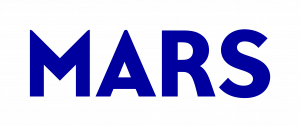
- D
Mars received the highest possible score for auditing and compliance. The company audits its compliance with marketing policies for all audiences to the same standards that it applies to auditing marketing to children, has the audit performed annually by an external auditor, covers all relevant media channels, and has a response mechanism for corrective action in place. Mars also has compliance levels for TV and digital marketing over 90% and gains full score for disclosure.
D1 Marketing policy: general aspects of responsible marketing
Overall, slight improvements can be seen in the different media channels for all audiences covered by company policies, and companies apply the same standards to these policies. Seven companies, including PepsiCo, Unilever, Mars and Nestlé apply their public responsible marketing policy to all media covered by ATNI methodology (see box 1), whereas only six companies did so in 2018. Twelve companies include several of the listed media in the scope of their policies, but not all. Of these, the media most often omitted were in-store/point of sales marketing and sponsorship.
The media channels least covered by company policies in 2018 were in-store marketing and cinema, which were only covered by policies of seven companies. The coverage of those media channels has since increased. In the Global Index 2021, eight company policies cover in-store marketing, and 13 companies have policies covering cinema (as part of additional forms of marketing).
In the 2018 index, 11 companies did not specify the media channels to which their responsible marketing policies apply. In this report, which includes three new companies, only six did not specify media channels.
Table 1 displays all relevant commitments made publicly by the companies. A total of 10 companies commit to a public responsible marketing policy related to the representation of products that is fully aligned with the ICC Framework. Since 2018, Kellogg and Meiji have joined the eight companies who already had such commitments (Mondelēz, Danone, Coca-Cola, Ferrero, Mars, Nestlé, PepsiCo, and Unilever) and now also pledge to comply within the ICC Framework.
Similar to 2018, Unilever, Danone, Mars, and Nestlé are the only companies to fully commit to the ICC Framework and go beyond by committing not to use models with a body mass index (BMI) of under 18.5, and to present products in the context of a balanced diet. Since 2018, no new companies have made these commitments. Nine companies did not make any relevant commitments aligned with the ICC Framework or beyond. In contrast to 2018, Campbell and Kraft Heinz were not credited for this indicator in the 2021 Index, because the updated methodology requires policies to be public for the companies to be credited, whereas this was not a requirement in 2018. Five companies did not make any relevant public commitments related to the representation of products in 2018. Of these, Meiji is the only company to improve its policy commitments, and now has a public ‘responsible marketing to children policy’ completely aligned with the ICC Framework.
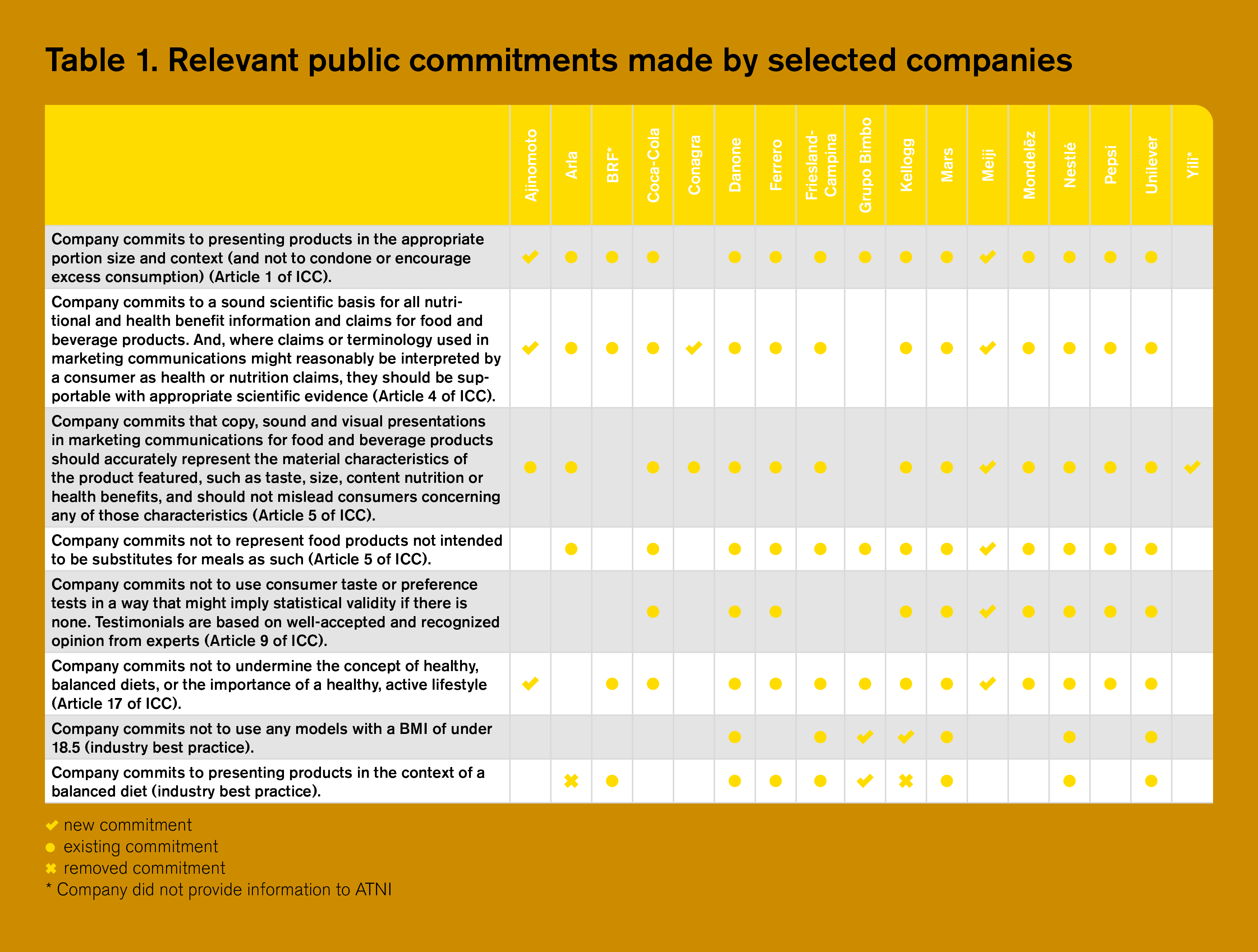 There is room for improvement in transparency in marketing policies. Of the 25 companies included in the Index, 14 do not commit to clearly display the company or brand name when advertising on virtual media, nor to ensure that the true commercial purpose of marketing communications is transparent and recognizable as an advertisement (in alignment with the ICC Framework Article 7). Eight companies include one of these commitments in their policies, and only three commit to both. Only PepsiCo, Unilever, Danone, and Coca-Cola disclose a commitment to clearly distinguish marketing messages from other content.
There is room for improvement in transparency in marketing policies. Of the 25 companies included in the Index, 14 do not commit to clearly display the company or brand name when advertising on virtual media, nor to ensure that the true commercial purpose of marketing communications is transparent and recognizable as an advertisement (in alignment with the ICC Framework Article 7). Eight companies include one of these commitments in their policies, and only three commit to both. Only PepsiCo, Unilever, Danone, and Coca-Cola disclose a commitment to clearly distinguish marketing messages from other content.
Besides FrieslandCampina, no company explicitly commits to developing and delivering marketing strategies appropriate to reaching priority populations, in all countries in which it operates. Notably, seven other companies which did not make explicit commitments, did provide evidence of steps taken to understand and reach priority populations through tailored marketing for appropriate products. Examples include promoting the consumption of iron-fortified foods to women at risk of anaemia or fortified fat-filled milk powder to low-income groups.
To further strengthen responsible marketing policies in the food and beverage sector, companies are encouraged to:
- Expand the scope of media channels covered by their marketing policies, and explicitly outline the channels in their policies. In-store/point of sales and sponsorship marketing is often excluded from marketing policies, and companies which do not explicitly include these channels in their policies are encouraged to do so. Furthermore, ATNI emphasizes the need for companies which do not specify to which media their policies apply, to explicitly state the media channels covered by their public marketing policies.
- Align their marketing commitments with the ICC framework, and show leadership by making commitments that go beyond the framework. At the time of this report, only 10 companies have marketing policies fully aligned with the ICC framework. The ethical guidelines published by the ICC are a minimum set of standards to ensure responsible marketing safeguarding better nutrition, and companies should strive to adhere to those.
- Increase commitment to transparency in their marketing policies. To date, only three companies commit to clearly display the company or brand name when advertising on virtual media and to ensure that the true commercial purpose of marketing communications is transparent and recognizable as an advertisement.
- Explicitly commit to developing and delivering marketing strategies appropriate to reaching priority populations. Twenty-four companies included in the Index do not make such a commitment. Although some do provide evidence of taking steps to understand and reach priority populations, companies are advised to include this as an explicit commitment in their marketing policies.
D2 Marketing policy: Specific arrangements regarding responsible marketing to children
Twenty out of 25 companies have a public policy that addresses responsible marketing to children specifically. Since the 2018 iteration of the Global Index, when this number was only 18, Meiji has implemented a new public policy. Of the companies measured for the first time in this iteration, only KDP has a policy addressing marketing to children specifically. Nineteen companies publish their policy for marketing to children in full or make public and explicit references to commit to industry-wide pledges or initiatives.
Box 2: The age range of policies for marketing to childrenA newly measured indicator is on the kind of products that a company considers suitable to advertise to children, including teens. Only Mondelēz, Unilever, Coca-Cola, and Mars do not advertise products to children below the age of 12. No company advertises only products meeting the WHO regional standards , but 15 companies advertise only products meeting the company’s own or industry association-related standards, to children under the age of 12. Six companies do not restrict product advertising or shared no information with ATNI. Arla specifies which part of the policy applies to all children under 18 years and which part to children under 12 years. Unilever extends the age range for digital marketing specifically from 12 to 13, as it commits not to market directly to children under the age of 13 on digital platforms. Nestlé has a similar approach, by committing not to market to children under the age of 13 on social media.
Regarding responsible marketing techniques and materials aimed at children, commitments of companies vary and there is room for improvement. An overview of the commitments made by companies in this area can be seen in Table 2.
Unilever scores the highest in this area, as it makes all commitments in two out of three categories of techniques and materials. Together with Nestlé and Kellogg, Unilever commits to all responsible marketing techniques laid out by the ICC Framework and UNICEF’s ‘A Child Rights-Based Approach to Food Marketing’, and even takes a further step by committing to ensure that marketing materials contain an educative message in relation to healthy diets and lifestyles, and not to brand merchandise aimed at children except related to healthy products – which is considered industry best practice. Fifteen other companies make commitments in this area, whereas seven companies make no commitments at all or shared no information with ATNI.
Regarding the use of children, celebrities, and fantasy and animated characters, Unilever and FrieslandCampina make all the relevant commitments laid out in the ATNI methodology. Fifteen companies made some commitments, while eight companies made no commitments or shared no information. In 2018, most companies had a commitment not to use third party fantasy and animated characters with a strong appeal to children, but only seven companies extended their commitments to only use their own fantasy characters when marketing healthy products. In 2021, 13 companies made such a commitment, some with the exception of point-of-sales and packaging.
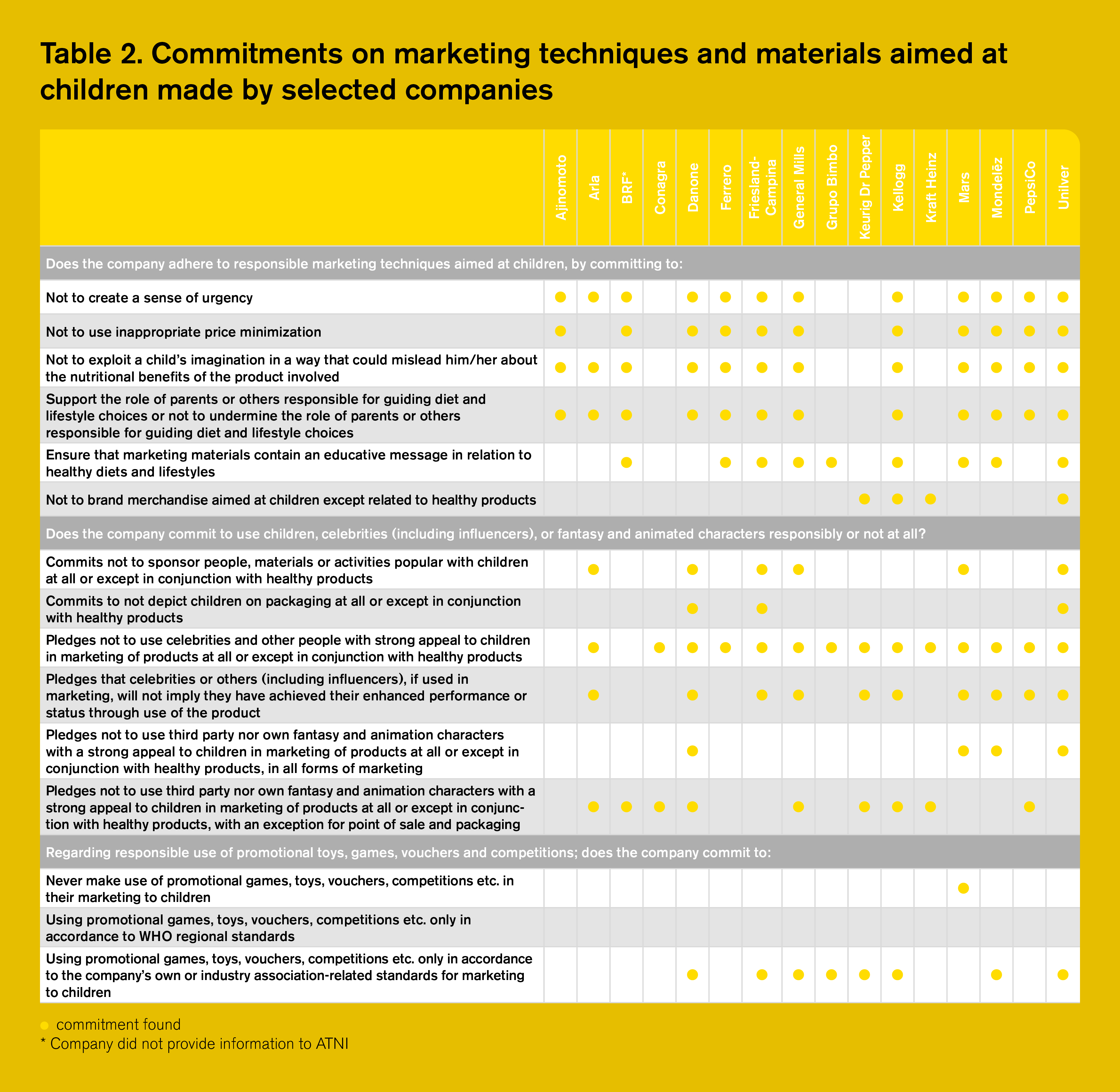
Mars is one of only two companies to make all commitments covered in the ATNI methodology for responsible use of promotional toys, games, vouchers and competitions. The company commits never to make use of these tools in their marketing to children. No companies commit to using these tools only in accordance with WHO regional standards, which would have given them the same score. Ten companies committed to using these tools only in accordance with the company’s own or industry association-related standards, while 13 companies made no relevant commitments at all or shared no information with ATNI.
The percentage of audience thresholds that companies use to restrict their advertising on measured media to avoid inappropriately reaching children, including teens, varies. Table 3 portrays audience thresholds used by companies and the corresponding age ranges. Eighteen companies included in the Index use audience thresholds to restrict their advertising, but the age range most often used is up to 12 years old. The lowest thresholds lie below 25%, which is only upheld by Unilever, Mars and Nestlé. Fourteen companies use between 26-35% as a threshold, whereas BRF uses a threshold above 50%. Seven companies do not specify a threshold used in their marketing strategies.
Box 3: Auditing of media channelsIn 2018, Arla was the only company to extend its age restrictions (for a specific part of their policy) to children below the age of 18; whereas most other companies with age restrictions had set them at 12 years old. Currently, Arla is still the only company to do so, while 16 companies use an age range up to the age of 12, and Campbell up to the age of six.
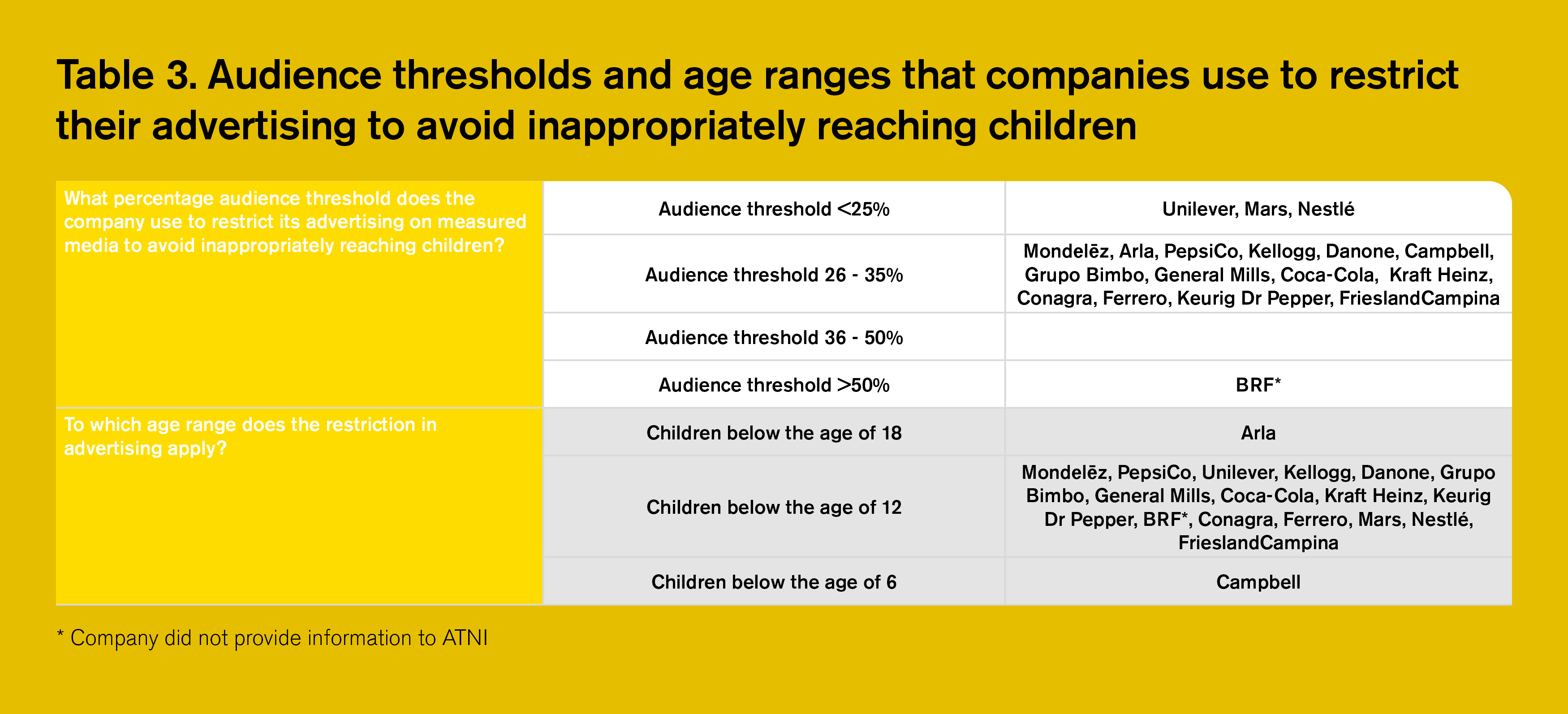
Mondelēz, Mars, and Nestlé are some of the companies that utilize all relevant tools laid out by the ATNI methodology to ensure that its digital marketing does not reach younger age groups and apply these tools to all forms of media. Box 4 provides an overview of the tools and strategies companies can use to prevent their digital marketing from reaching children, including teens, and why this is important. Thirteen companies apply some of the tools listed, while eight companies do not apply any or shared no information.
Box 4: Children’s rights and digital marketing
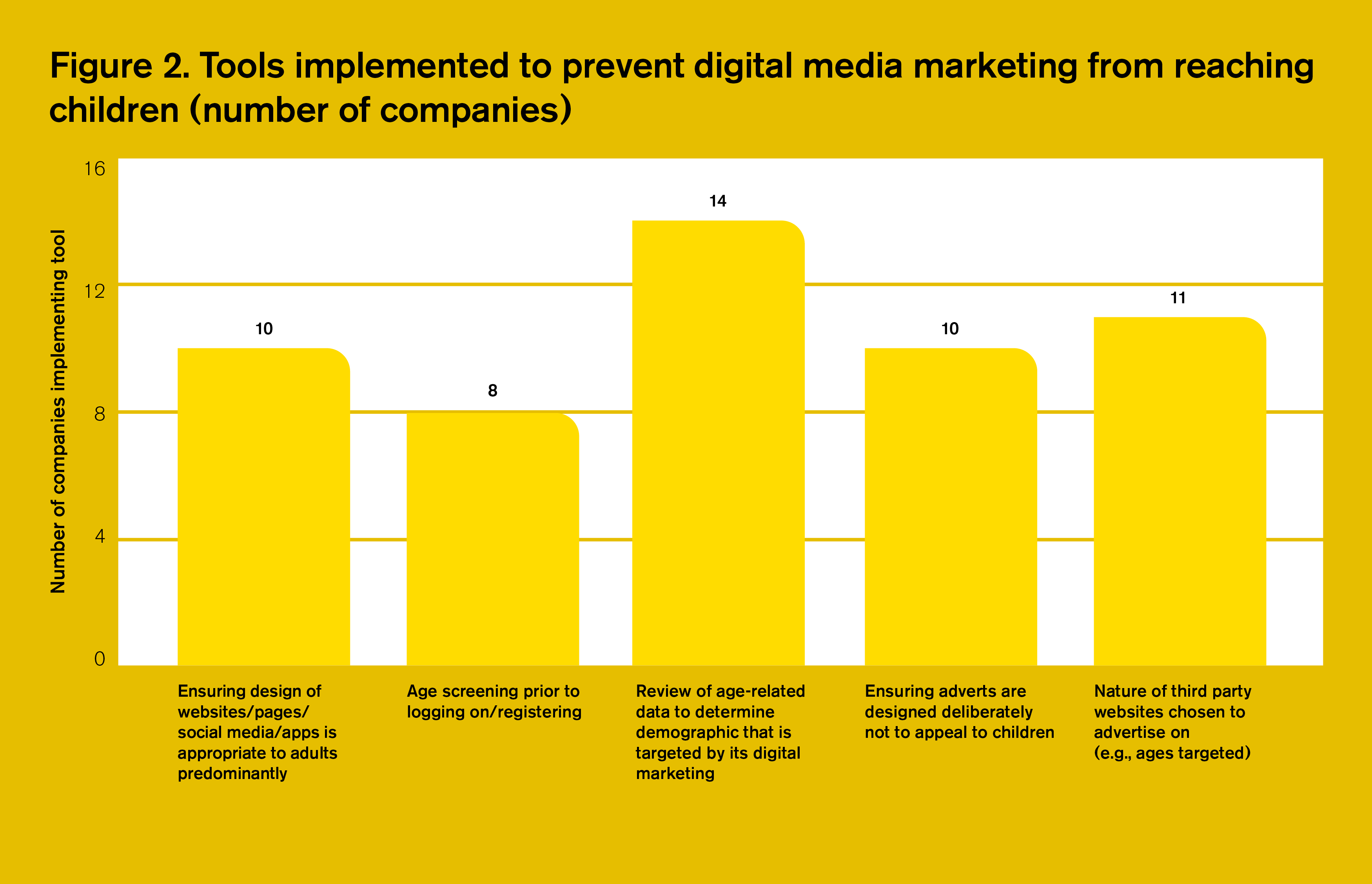
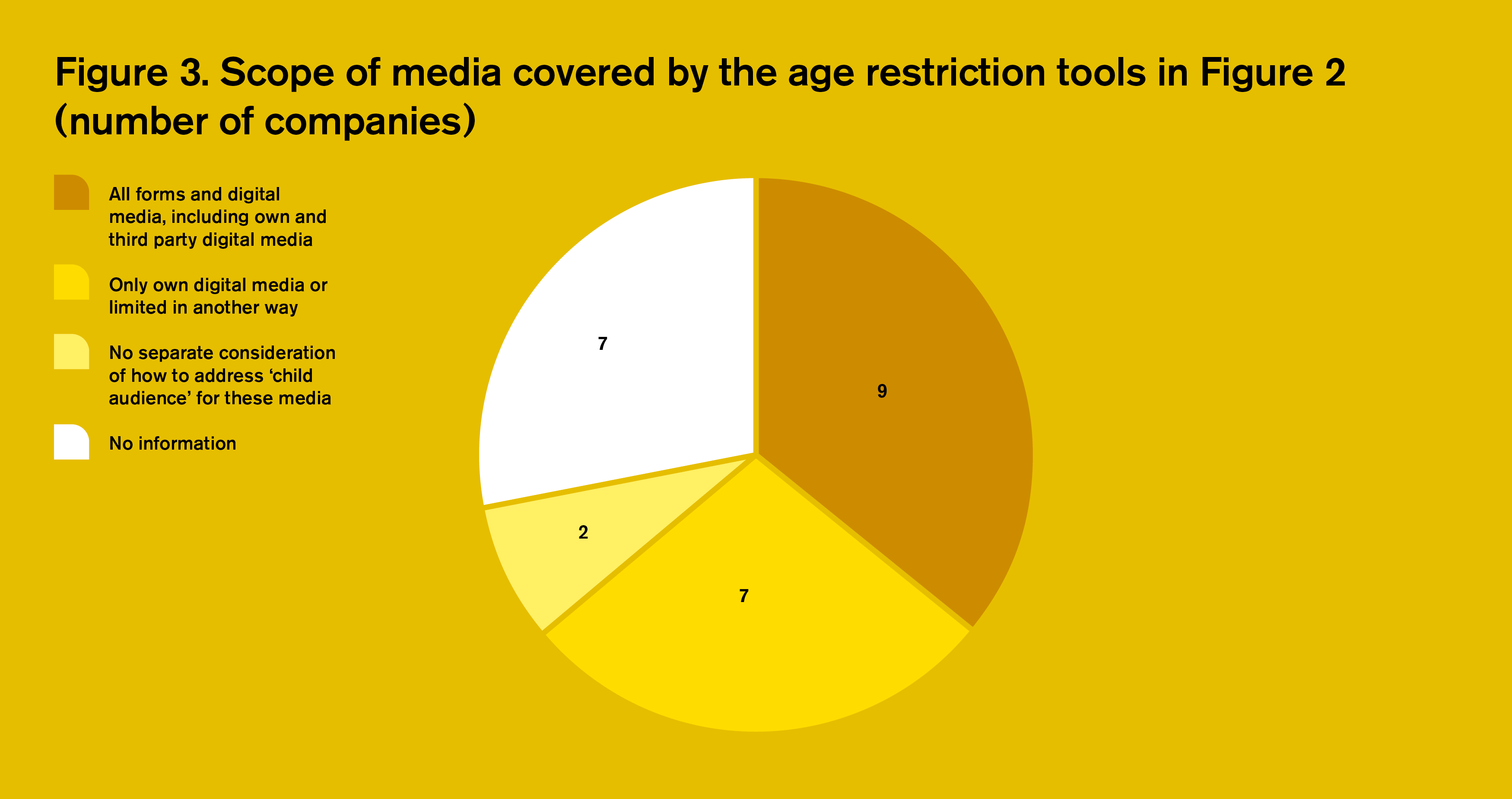
Figure 2 shows the different tools covered by the ATNI methodology, that companies can use to prevent their digital media from reaching younger age groups, and the amount of companies in the Index using them. Figure 3 shows percentages of companies in the Index applying tools to different digital media.
In 2018, marketing around schools was an area in which little progress had been made. For most companies (16) marketing restrictions only applied inside primary schools. Companies which extended their commitment to areas near primary schools were Nestlé (for ice-cream, confectionary, and water-based beverages) and Danone. Coca-Cola has made this same commitment since then for Australia, but 14 companies still limit the scope of their commitment to inside primary schools. Two companies commit to only market ‘healthy’ products in or near primary schools, and six companies have made no relevant commitment or shared no information. Importantly, the nutritional criteria or NPMs used by companies vary, meaning their definitions of ‘healthy’ products do as well. Therefore, the range of products deemed ‘healthy’ enough to market inside schools may differ per company. For more information on nutritional criteria and NPMs used by companies, see the Products chapter (B).
Responsible marketing commitments in and around secondary schools are even less robust, as only Coca-Cola extends its commitment to areas near secondary schools. Only six companies commit not to market in secondary schools, four companies to advertise only ‘healthy’ products in or near secondary schools, and 14 companies do not have a relevant policy or did not share information. Although this is a slight improvement compared to 2018, where only four companies made a commitment not to market in secondary schools, companies are recommended to extend their policies to secondary schools to include teens in their responsible marketing policies. Danone, a company that showed best practice in this area in 2018, updated its pledge, which does not contain explicit reference that the company has maintained a commitment not to market near secondary schools.
Improvements have been made in the way companies advertise in schools. In this index, for school related marketing, six companies explicitly commit to include new media marketing in their policies, and to only offer ‘educational materials’ when in agreement with schools or parents. Eight companies commit to either one of these.
Besides schools, other places where children gather, such as childcare, other educational establishments, or family and child clinics, are scarcely covered by company policies and remain an area for improvement. Eight companies commit to only market “healthy” products in or near these settings. The other companies have made no relevant commitments or shared no information.
Box 5: Marketing to children in the public space
To further strengthen marketing policies in the food and beverage sector, companies are encouraged to:
- Not advertise any products to children, including teens, or only advertise products meeting WHO regional standards. Most companies use their own or industry association-related standards for restricting advertising products to children, including teens, whereas not advertising any products, or only those meeting the WHO regional standards, is the gold standard for marketing to children policies. Companies are also encouraged to increase the age range for this restriction to 18.
- If companies do choose to advertise products to children, they are recommended to use responsible marketing techniques aimed at children, including teens. Commitments regarding responsible marketing techniques and materials to protect children are not robust or complete enough. Companies are recommended to follow industry best practices described in this chapter, by making these relevant commitments to protect the vulnerable group of children, including teens, from unethical and irresponsible marketing.
- Lower audience thresholds used to restrict its advertising on media to below 25%, apply this restriction to all children below the age of 18, and apply this beyond measured media only. Currently, only three companies use an audience threshold below 25%, and only one company applies their threshold to children below the age of 18.
- Extend marketing restrictions to fully cover the school environment (both primary and secondary), and other places where children, including teens, typically gather. Furthermore, companies could show industry leadership and voluntarily restrict their marketing practices in public spaces where children are likely to be exposed to them.
D3 Auditing and compliance with policy
Only five out of 25 companies – Mondelēz, Arla, Mars, Nestlé and FrieslandCampina – audit compliance with their marketing policies covering all audiences, while 12 companies audit their compliance for children only. Mars and FrieslandCampina assess compliance of all aspects of marketing (covering all audiences) to the same standards applied to children, which is considered best practice. The other three companies use less restrictive standards for general audiences. Currently, only eight companies do not report having any type of auditing mechanisms in place. This is an improvement compared to the 2018 Index, where 16 companies did not report on auditing. However, only eight companies disclose information about their audits publicly.
In addition to Danone, Mars and Nestlé, who already had such policies in place in 2018, FrieslandCampina now also appoint an independent external auditor (not related to, or in addition to, an industry association-appointed third-party auditor) to assess compliance regarding children – another best practice encouraged by ATNI. However, progress has to be made in this area, as 13 companies have their audit undertaken by an industry association or an industry association-appointed third-party auditor.
While most companies that audit their compliance perform an annual audit for children only and less frequently for all audiences, Arla, Mars, Nestlé and FrieslandCampina undertake an audit covering all audiences (including children) annually.
Importantly, all companies that are signatories of the EU pledge are required to monitor and report on the implementation of their commitments. Therefore, all signatories are automatically credited for auditing their marketing practices to children annually by an industry association (appointed) third-party auditor across all media, and for some disclosure elements.
Eight companies audit compliance across all media and in all its forms. Of the remaining nine companies which perform audits, six audit compliance across main print, traditional and digital media, but with no specific reference to the forms of marketing used, and three audit compliance across a limited selection of media, although details are unclear. In some instances, audits are initiated by industry associations (e.g., the EU pledge) or governments (e.g., the Dutch ministry of Health). Even if companies are audited as commissioned by these external organisations, the companies are encouraged to initiate (additional) external audits from within.
For TV and digital marketing, compliance levels (of companies that audit) are generally high. Eleven companies have compliance levels over 90% for TV, of which only four (Danone, Mars, Nestlé and FrieslandCampina) are assessed by an independent external auditor, while seven are assessed by an industry association (appointed) third party auditor. Ten companies have compliance levels over 90% for digital marketing, of which (the same) four are assessed by an independent external auditor, and six by an industry association (appointed) third party auditor. However, disclosure by companies on this topic is limited, as the remainder of companies which perform audits do not report on their compliance levels, and only five companies in total publicly disclose their compliance levels. Additionally, only five companies – Unilever, Danone, Coca-Cola, Mars, and Nestlé – have a response mechanism to ensure corrective measures are taken regarding any noncompliance with its marketing policy.
To further strengthen marketing policies in the food and beverage sector, companies are encouraged to:
- Perform annual audits on its compliance with its marketing policy, where possible by an external auditor, and disclose information about this audit publicly. Currently, most audits are performed for child audiences only, and those who do perform audits for all audiences often hold this to lower standards than audits covering children. Although this is an improvement compared to 2018, more remains to be done. Even if audits are initiated by relevant governments or industry associations, companies are encouraged to implement (additional) external auditing.
- Increase transparency regarding compliance. As only five companies disclose their compliance levels publicly, compliance to responsible marketing policies cannot be checked and companies cannot be held accountable for their marketing practices.
- Implement response mechanisms to ensure corrective measures after noncompliance with a marketing policy.
Products found suitable to be marketed to children
This part of the product profile assessment gives an indication on the number of products which are considered suitable to be marketed to children, but does not impact company scores in Category D. The Product Profile is an independent assessment of the nutritional quality of companies’ product portfolios undertaken by analyzing the levels of fat, salt, sugar, and other components within individual products. ATNI commissioned an independent research organization, The George Institute for Global Health, to undertake the nutrition profiling element of the Product Profile.
Two sets of results are generated for each company: one to determine the nutritional quality of the company’s products, by applying the Health Star Rating (HSR) at both category and portfolio level, and another by using market-specific WHO regional NPMs to determine what percentage of products are suitable to be marketed to children.
This assessment does not investigate whether these products are, in practice, marketed to children by the companies, but rather, if they are suitable to. If companies are found to have a large proportion of products not suitable to be marketed to children, it is of high priority that the company implement a rigorous responsible marketing policy for children and tries to increase the number of healthier products in its portfolio.
Importantly, this assessment does not affect companies scoring in the Index. In contrast, the Product Profile results using the HSR system are integrated in Category B. This assessment provides an additional perspective on the healthiness of companies’ portfolios.
To select the products to be included in this assessment, a maximum of 10 major markets are selected, aiming to cover 80% or more of the company’s global retail sales (fiscal year 2019). For each market, the top five best-selling product categories are identified, of which all products are included in the assessment. Details on the scope of this assessment are provided in Table 4 below.
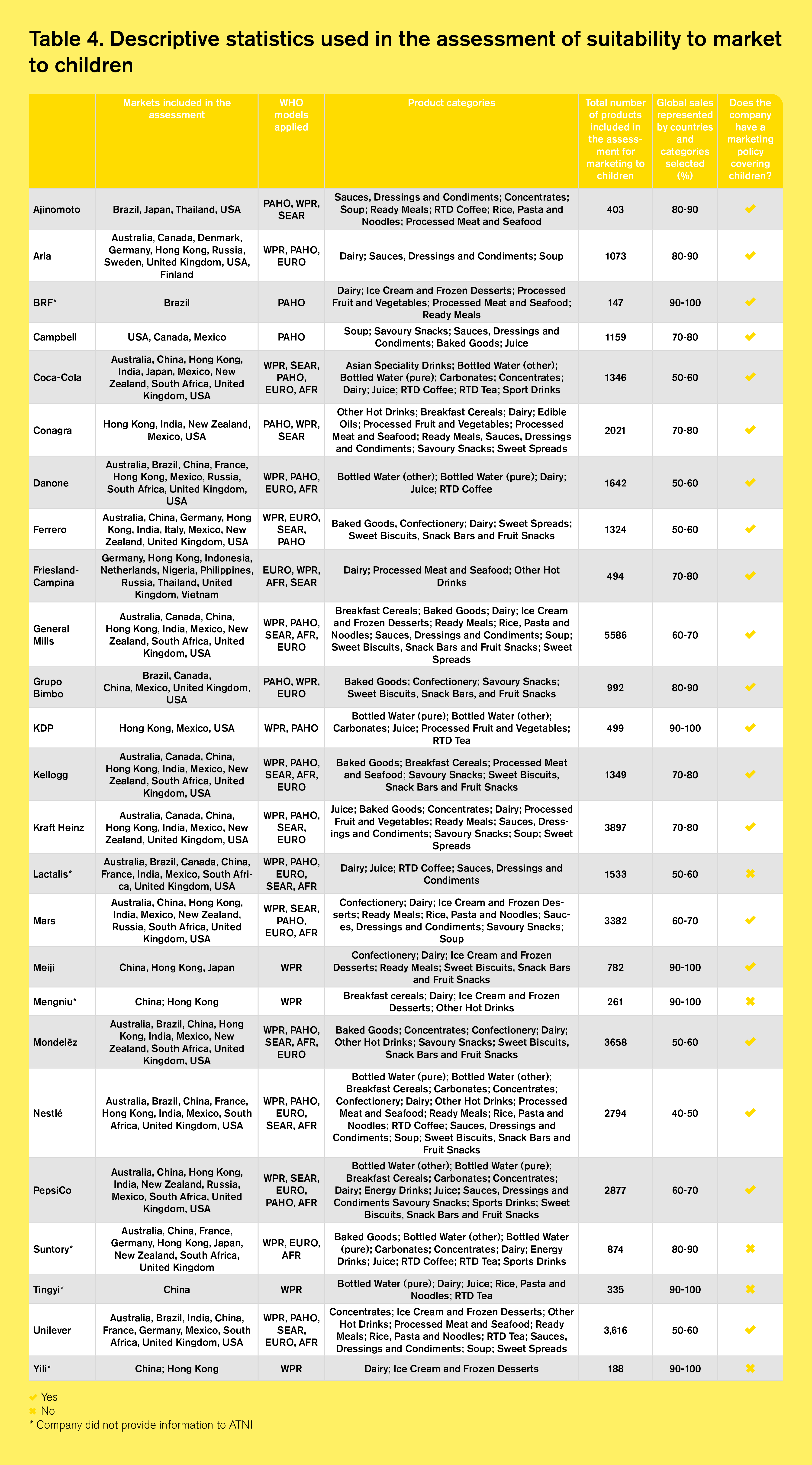 The proportion of products found suitable to be marketed to children, and the sales derived from these products, can be seen in Figure 4. In total, only 3493 out of 38852 assessed products were found suitable to be marketed to children based on the criteria of the relevant WHO NPMs. This represents 9% of the distinct products assessed and 9% of the sales value of packaged foods of all companies combined. This is considerably lower than the results of the Product Profile section in Category B, where 31% of assessed products was found to meet the ‘healthy’ threshold with an HSR above 3.5. This lower result reflects the more stringent criteria applied in the WHO models, on account of different nutritional needs of children compared to adults (entire categories are ineligible under the WHO criteria, whereas the HSR uses a cut-off point to determine healthiness). None of the 25 companies assessed were found to have a considerable proportion of assessed products suitable to be marketed to children (more than half the products in their portfolios meeting WHO criteria). This highlights the urgent need for companies to improve their product portfolios to offer healthier products, especially for children, including teens, and strengthen their responsible marketing policies practices to protect children’s rights to healthy diets.
The proportion of products found suitable to be marketed to children, and the sales derived from these products, can be seen in Figure 4. In total, only 3493 out of 38852 assessed products were found suitable to be marketed to children based on the criteria of the relevant WHO NPMs. This represents 9% of the distinct products assessed and 9% of the sales value of packaged foods of all companies combined. This is considerably lower than the results of the Product Profile section in Category B, where 31% of assessed products was found to meet the ‘healthy’ threshold with an HSR above 3.5. This lower result reflects the more stringent criteria applied in the WHO models, on account of different nutritional needs of children compared to adults (entire categories are ineligible under the WHO criteria, whereas the HSR uses a cut-off point to determine healthiness). None of the 25 companies assessed were found to have a considerable proportion of assessed products suitable to be marketed to children (more than half the products in their portfolios meeting WHO criteria). This highlights the urgent need for companies to improve their product portfolios to offer healthier products, especially for children, including teens, and strengthen their responsible marketing policies practices to protect children’s rights to healthy diets.
For Nestlé, 11% of assessed products in its portfolio were found suitable to be marketed to children, but the company derives 21% of its sales from these products, demonstrating higher sales of these products suitable to market to children. The same applies to Suntory, with a portfolio proportion of 3%, but a sales proportion of 11%. On the other hand, companies such as Kraft Heinz, Unilever, Danone and FrieslandCampina have a relatively high proportion of assessed products suitable to market to children, but the proportion of sales derived from these products is 7% lower than the respective proportion of the portfolio. Companies are encouraged, even if the profile of their products is generally considered less healthy, to increase the sales of those products that are considered healthy.
Ferrero had no products included in the assessment eligible for marketing to children at all. It is therefore essential for the company, and other companies that score lower in this section, to implement a robust marketing policy and thoroughly audit their compliance.

To improve and accelerate their efforts to support consumers, especially children (including teens), to access healthy foods, food and beverage manufacturers are encouraged to:
- Make a commitment not to advertise products to children (including teens) at all, or to only market foods and beverages that meet specific nutrition criteria, preferably established by independent national or international bodies (e.g. WHO Regional NPMs).
- Improve their product portfolios to significantly increase the number of products meeting the relevant WHO criteria. Overall, only 9% of the assessed products of all companies meet the WHO criteria and are therefore suitable to be marketed to children.
- Increase sale of products meeting the WHO criteria compared to products which do not. If companies have a relatively less healthy product portfolio, they may still improve their practices in this area by increasing relative sales of healthy products compared to unhealthy products.

